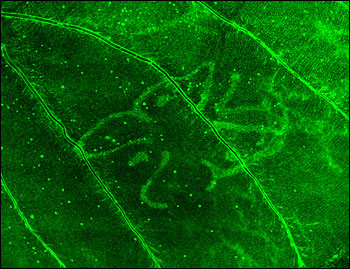Lasers 'Turn On' Genes in Butterfly Wings
BUFFALO, N.Y., Nov. 29, 2006 -- An innovative
tool has been developed that allows scientists studying "nonmodel"
organisms to directly test the function of certain genes, even without
genome sequencing information.
The University of Buffalo (UB)
researchers demonstrated their method by stenciling the silhouette of a
butterfly right on the surface of a butterfly's wing, an affect
achieved by using lasers to "turn on" fluorescent marker genes in a
very precise pattern. The butterflies were otherwise unaffected.

Green
fluorescent protein is produced in precise patterns on the butterfly
wing by laser activation of the correspondent gene through a cut-out
stencil.
Biologists studying "model" organisms, like the
fruit fly or the mouse, have at their disposal highly sophisticated and
efficient tools that allow them to explore functional genetics in these
animals.
But
researchers seeking to discover how genes work in other organisms have
had a limited set of tools with which to test gene function. Most of
these tools are very difficult to localize to particular areas of the
developing animal, especially since the regulatory code of such
organisms still is poorly understood.
"With this research, we
have developed a tool to test gene function in an animal where these
kinds of tools were not available before," said Diane Ramos, a doctoral
candidate in the UB Department of Biological Sciences in the College of
Arts and Sciences and co-first author on a paper about the research
with Firdous Kamal, who earned his master's degree at UB.
"We
hope to inspire other researchers working in nonmodel organisms to use
these kinds of techniques to answer fundamental questions about what
genes do, which will allow interesting comparisons between species."
According
to Antonia Monteiro, former UB assistant professor of biological
sciences and leader of the UB research team, the method involves
introducing a heat-sensitive piece of regulatory DNA into the genome of
butterflies along with the genes that they wanted to activate at
precise positions and times during wing development.
"As the
laser heats up specific cells on the butterfly wing, genes that sit
next to this regulatory sequence get turned on, allowing for specific
clusters of cells on the wing to fluoresce," said Monteiro, assistant
professor of ecology and evolutionary biology at Yale University.
The
UB/Yale researchers now are using this tool to connect the heat switch
to the genes that have been implicated in controlling the intricate
patterns on butterfly wings.
"We want to be able to turn on or
shut down specific genes on the developing butterfly wing in order to
test their function in coloring the wing," said Monteiro.
She
added that the tool also may be useful to scientists working on the
color patterns of other insects, fish, birds or plants who could use
similar systems to perturb the expression of genes implicated in
specific developmental pathways.
"Now they may be able to attempt to use a laser beam to direct gene expression to particular clusters of cells," she said.
The
new tool was tested in a transgenic line of Bicyclus anynana
butterflies containing the GFP reporter gene -- a common jellyfish
marker gene -- attached to a Drosophila heat shock promoter, which
produced the same heat-sensitive response in butterflies.
In
addition to Ramos, Kamal and Monteiro, co-authors on the paper are
Alexander N. Cartwright, PhD, UB professor of electrical engineering;
and Ernst Wimmer from Georg-August-University Göttingen in Germany.
Both
Ramos and Kamal were supported in this research through the National
Science Foundation-funded Integrative Graduate Education Research and
Traineeship in Biophotonics. This IGERT program at UB was one of the
nation's first comprehensive, multidisciplinary training program for
biophotonics scientists, designed to train a new breed of 21st-century
scientist, one who is well-versed in and able to conduct research in
biological, photonic and electronic systems. Additional NSF grants also
supported the work.
The paper describing this research was
published in BMC Developmental Biology, an open-access journal; a copy
of the paper is available at:
www.biomedcentral.com/1471-213X/6/55/abstract
Start a discussion on this article or any photonics topic in the Photonics.com Community Forum